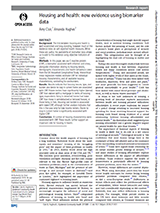Housing and health: new evidence using biomarker data

The link between housing and health is well established and long-standing, however much of the evidence relies on self-reported health measures. While these are useful, the availability of biomarker data allows us to add to this evidence using objective indicators of health.
In this paper C-reactive protein (CRP), a biomarker associated with infection and stress, alongside information relating to housing details, demographic characteristics and health behaviours taken from the UK Household Longitudinal Study are used to measure health.
The results indicate that housing tenure, type, cost burden and desire to stay in current home are associated with CRP. Private renters have significantly higher (worse) CRP than owners with a mortgage. In terms of housing type, respondents living in detached homes had lower CRP than those in semidetached or terraced houses, or those living in flats. Housing cost burden is associated with lower CRP, although further analysis indicates that this is the case only for low-income renters. Desire to stay in current home is significantly associated with higher CRP.
